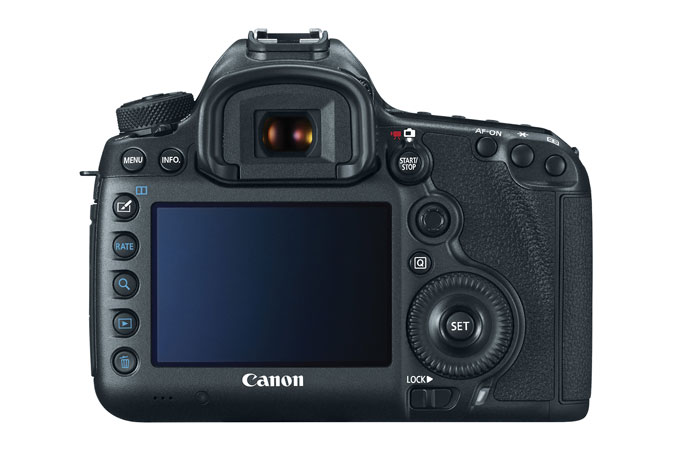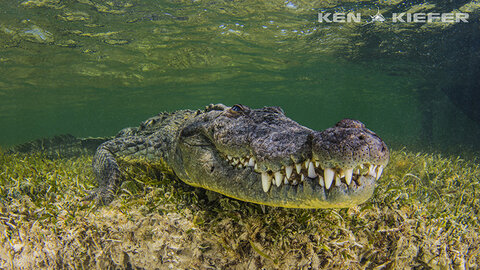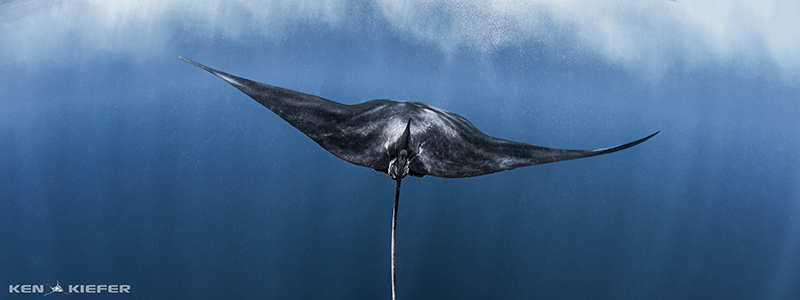Canon 5Ds Camera Review

The megapixel war between camera manufacturers has been reignited over the past year, with several mega-megapixel camera bodies entering the market. Canon's entry is the Canon 5Ds and 5Ds R, which pack 50.6 megapixels into the same body frame as the Canon 5D Mark III.
As underwater photo and video shooters, we look to the Canon 5Ds. The 5Ds R cancels the low-pass filter that is built into most DSLRs (including the 5Ds). This produces an ever slightly sharper image, but makes the camera much more susceptible to the effects of moire when shooting things like fabric (i.e. wedding dresses) or architecture. Suffice it to say that the 5Ds is the better choice unless you're well-versed in AF microadjustments on your lenses and advanced post-processing techniques.
The high-resolution of the Canon 5Ds makes it the perfect camera for those who make large photo prints, or for those who need the freedom to make major crops of their images. This very high resolution makes it essential to use high-quality lenses and achieve crisp, sharp focus.
The Canon 5Ds and 5Ds R also have an Intervalometer and a Time-Lapse Movie Mode that provide two different time-lapse options. These are useful for those shooting video who don't already have other time-lapse accessories or software like Magic Lantern, and those shooting time-lapses inside their housings where accessories won't fit.
Quick Links: 5D Mark III Comparison | ISO Tests & Comparison | Macro Test & Comparison | Sensor Ratings | Best Lenses | Underwater Housings
Canon 5Ds Specs
50.6MP CMOS sensor
Full frame (35mm sensor)
61-point autofocus system
RAW image capture in several aspect ratios
Full HD video recording
CF and SD (SDHC, SDXC) memory cards




Canon 5Ds Comparision with 5D Mark III
Through the years, I’ve used a few different setups for capturing images or video underwater. From a Sea&Sea MX-10 I progressed through some video-only setups, a Nikonos V, and Canon’s early Rebel cameras in my pursuit to show others some of the incredible sights of the underwater world.
In the never-ending march of technological progress, most photographers end up asking themselves every couple of years or so whether enough has changed to make a camera upgrade worthwhile.
Last year, I was trying to decide whether my Canon 5DMark3 had come to the end of its run in favor of the recently released Canon 5Ds.
But it turned out that I didn’t really have to choose. Through a turn of events, one of my friends made me a deal that I could not pass up - to trade my backup 5D3 for a lightly used 5Ds and an unused lens.
Because Canon uses the same physical frames for both cameras; and basically left all the controls in the same locations, I can fit both cameras in my Ikelite housing without any sacrifice or modification. All of the buttons and dials work perfectly.
Finding myself with the decision to choose between the two cameras, I generally grab the 5Ds any time I’m going to shoot underwater. But the reasons that I generally grab this camera aren’t cut and dry.
5Ds vs 5D Mark III
Both cameras have basically the same weight, size, screen, controls, etc. They also produce images that are for most intents and purposes identical.
However, there are two factors that help tilt me in the direction of the 5Ds. First is the fact that it has 50 megapixels. I don’t print out images 60” and up very often, but every once in a while I do, and several of my customers do as well. Having such a huge file does make a difference for the really large prints. And, I never know for sure while taking a shot whether I might love it enough to want the overload of pixels. The other factor is a little hard to put my finger on. The images come out of this camera with a little different feel than the ones from the 5D3. It’s nothing I can point out, and it’s not even possible to see unless I’m working with the full resolution images on my large screen at home. It could be that the added depth from so much resolution creates a velvety texture. It’s also possible that it’s all in my head : )
The focus speed on both the 5D3 and 5Ds is superb. In the water and on land, I can detect no difference in subject asquisition or the ability of both cameras to maintain AI Focus on moving subjects.
The 50.6 megapixel files do come with some compromise. The need to stock up on large/fast memory cards is pretty evident. I don’t use anything smaller than 64GB and usually prefer 128GB. Also, working with and storing the files requires some different equipment. I had to upgrade my external storage. And, while I was doing that, I went with Thunderbolt connections to speed up the transfer.
There are times that I choose to load the 5DMark3 in my housing over the 5Ds. Usually, I choose the 5D3 when I’m going to be shooting all day; either with a swim team or a large fashion shoot.
To handle processing the larger files, the 5Ds uses more processing power, which takes more battery power. Depending on how much image review I do, I’ve found approximately 25-30% less shots possible with 5Ds versus 5D3 in similar situations before needing to swap batteries. And, that is more of an extreme case. I sometimes take over 2500 shots of a swim team in a day. Not a normal occurrence for most underwater shooters.
ISO Tests and Comparison
 The Canon 5Ds and Canon 5D Mark III have excellent performance shooting at higher ISOs. Ken set up some tests with both cameras to evaluate image quality when shooting at the base ISO of 100, as well as ISO 6400, which is useful for subjects like topside wildlife, surfers during the golden hours and indoor shooting.
The Canon 5Ds and Canon 5D Mark III have excellent performance shooting at higher ISOs. Ken set up some tests with both cameras to evaluate image quality when shooting at the base ISO of 100, as well as ISO 6400, which is useful for subjects like topside wildlife, surfers during the golden hours and indoor shooting.
Below are the original .jpg files followed by 100% crops of the RAW files, exported from Adobe Photoshop as unmodified .jpg files at 100% quality (no optimizing, etc). These photos were all shot with the Canon 85 f/1.2L lens.

1) 5D MkIII @ ISO 100, f/1.8, 1/80
2) 5D MkIII @ ISO 6400, f/5.6, 1/250
3) 5Ds @ ISO 100, f/1.8, 1/80
4) 5Ds @ ISO 6400, f/5.6, 1/250


Image left: Canon 5D MkIII - ISO 100, f/1.8, 1/80
Image right: Canon 5Ds - ISO 100 f/1.8, 1/80


Image left: Canon MkIII - ISO 6400, f/5.6, 1/250
Image right: Canon 5Ds - ISO 6400 f/5.6, 1/250
In looking closer at these 100% crops it's easy to see the additional resolution of the Canon 5Ds (which is why you see less of the subject in the frame than the 5D Mk3 photos). It's also apparent that the images shot with the 5Ds are slightly darker than those with the 5D Mk3. This is due to the increased pixel density of the 35mm sensor on the 5Ds, where each pixel picks up slightly less light.
Both cameras show great IQ at ISO 100, but it's not quite fair to compare the noise and depth of field of each camera at 100% crop for ISO 6400, so I've created a new crop from the 5Ds ISO 6400 image to match the 100% crop of the 5D MkIII image for a fair comparison.


With pictures being equal, we can see that the depth of field of each image appears equal (as it should for same-size sensors). We can also see that noise at ISO 6400 is virtually the same.
In conclusion, high ISO noise performance on these cameras is great. What you do see can be easily smoothed out during post-processing. The 5Ds requires slightly more light, so underwater video shooters will need to open the aperture 1/3 stop more (decreasing DOF) or increase their ISO a 1/3 stop to create the equivalent exposure.
Canon 5Ds vs. 5D Mark III Macro Test
For macro testing, Ken was able to set up both camera bodies in his Ikelite housing (one at a time, of course!) with Ikelite DS161 strobes, shooting the below photos with the Canon 100mm f/2.8L macro lens.



Both cameras show excellent quality when set up in a housing. Note that composition and strobe lighting were changed somewhat when switching cameras, so these photos serve only as indicators of image quality. You better believe that those nudibranch rhinophores will be sharp and crisp with either camera.


DxOMark Sensor Rating
Let's geek out a second. DxOMark is a group that provides independent image quality measurements and comparisons via RAW file. For this section of the review we'll look at sensor measurements for the Canon 5Ds.
Canon 5Ds
Overall Score: 87
(Nikon D810: 97, Canon 5DMkIII: 81 bits, Sony a7R II: 98)
Portrait (color depth): 24.7 bits
(Nikon D810: 25.7 bits, Canon 5DMkIII: 24 bits, Sony a7R II: 26 bits )
Landscape (dynamic range): 12.4 Evs
(Nikon D810: 14.8 Evs, Canon 5DMkIII: 11.7 Evs, Sony a7R II: 13.9 Evs )
Sports (low-light ISO): 2381 ISO
(Nikon D810: 2853 ISO, Canon 5DMkIII: 2293 ISO, Sony a7R II: 3434 ISO )
Source: DxOMark.com
What Does This Mean for Underwater Photography?
The DxOMark scores above must be interpreted with proper context. Let's go through color depth and dynamic range:
Color Depth: Color sensitivity of 22 bits is excellent, and differences below 1 bit are barely noticeable. The 5Ds is rated well into "excellent", although ranking below the Nikon D810 and Sony a7R II.
Dynamic Range: A value of 12 Ev is excellent, with differences of 0.5 Ev usually not noticeable. The 5Ds ranked about 12 along with the D810, but the 5D3 and a7R II fell below.
Source: DxOMark.com
This must all be taken with a grain of salt. The results above speak for themselves, but it is important to remember that this sensor data is only one small piece of the image-making equation. Equally important is what the camera does with that information, which is why the debate over best IQ will always continue among pixel-peeping photographers.

Best Lenses
Canon full-frame DSLRs benefit from high-quality lenses. This is especially true for the Canon 5Ds and 5Ds R's large resolution. We've listed the most popular lenses for underwater photography below.
Canon 100mm f/2.8L Macro Lens Review
- This is the best macro lens for Canon full-frame shooters.
Canon 8-15mm Fisheye Lens Review
- The fisheye lens of choice for Canon full-frame shooters, offering traditional wide-angle shots at 15mm and circular shots at 8mm.
Canon 16-35mm f/2.8L II Wide-Angle Lens
- Popular wide-angle lens for Canon full-frame shooters. Other excellent options include the 16-35mm f/4L and the 17-40mm f/4L wide-angle lenses.
Canon 11-24mm f/4L USM Ultra Wide-Angle Lens
- An ultra wide-angle lens for Canon full-frame shooters. This lens has excellent image quality, but comes with heavy weight and price tag.
Related Reviews
Canon 5Ds Underwater Housings
The Canon 5DS and 5DS R will fit in housings designed for the Canon 5D Mark III, which is very convenient for those who have both DSLR bodies. Below is Bluewater Photo's selection of housings.

The Ikelite Canon 5D Mark III housing (fits the 5DS) is full-featured yet affordable and includes built-in TTL conversion circuitry that puts perfect exposure at you fingertips. Uses the traditional Four Lock Mount port system.
Read our Ikelite Canon 5D Mark III housing review.
For more info and recommended ports and accessories, visit Bluewater Photo's Ikelite Canon 5D Mark III housing page.

The Ikelite Dry Lock Port Mount housing fits the Canon 5DS, 5DS R, 5D Mark IV and 5D Mark III cameras. This new port system makes changing ports and lenses simple, secure and easy.
View the Ikelite Dry Lock Port 5D MkIV Housing at Bluewater Photo.
 The Aquatica Canon 5DS R housing (fits the 5DS, 5DS R, 5D Mk III) is precision built with smooth knob and button operation that will feel like new no matter how much you use and abuse it.
The Aquatica Canon 5DS R housing (fits the 5DS, 5DS R, 5D Mk III) is precision built with smooth knob and button operation that will feel like new no matter how much you use and abuse it.
Read our Aquatica Canon 5D Mark III housing review.
For more info and recommended ports and accessories, visit Bluewater Photo's Aquatica Canon 5DSR housing page.
 The Nauticam Canon 5D Mark III housing (fits the 5DS) is intricately engineered to re-position camera controls to the most ergonomic and convenient locations on the housing, plus converter for fiber optic cable use.
The Nauticam Canon 5D Mark III housing (fits the 5DS) is intricately engineered to re-position camera controls to the most ergonomic and convenient locations on the housing, plus converter for fiber optic cable use.
For more info and recommended ports and accessories, visit Bluewater Photo's Nauticam Canon 5D Mark III housing page.
 The Sea & Sea Canon 5D Mark III housing (fits the 5DS) is a compact and popular housing. This Version II housing features a built-in converter for fiber optic cable use and TTL shooting.
The Sea & Sea Canon 5D Mark III housing (fits the 5DS) is a compact and popular housing. This Version II housing features a built-in converter for fiber optic cable use and TTL shooting.
Fore more info and recommended ports and accessories, visit Bluewater Photo's Sea & Sea Canon 5D Mark III housing page.

Conclusion
The Canon 5Ds packs a whopping 50.6 megapixels into the body of the Canon 5D Mark III. If you own a 5D Mark III and are considering upgrading, you will not be disappointed. Just make sure that your computer and hard drives can handle the large amounts of data.
If you are deciding between the 5D MkIII and the 5Ds, there are pros and cons for each camera. The 5Ds offers greater resolution for large prints or large crops, but battery life is a little less, the files will move slower on your computer and technical aspects of photography, like focus, are critical. The 5D MkIII is a proven workhorse for full frame shooters but doesn't offer you the massive amount of resolution of the 5Ds.
Luckily, both cameras fit in all the 5D Mark III underwater housings, and the nice L glass you buy is compatible with most Canon DSLRs.
RECOMMENDED ARTICLES
SUPPORT THE UNDERWATER PHOTOGRAPHY GUIDE:
The Best Service & Prices on u/w Photo Gear
 Visit Bluewater Photo & Video for all your underwater photography and video gear. Click, or call the team at (310) 633-5052 for expert advice!
Visit Bluewater Photo & Video for all your underwater photography and video gear. Click, or call the team at (310) 633-5052 for expert advice!
The Best Pricing, Service & Expert Advice to Book your Dive Trips
 Bluewater Travel is your full-service scuba travel agency. Let our expert advisers plan and book your next dive vacation. Run by divers, for divers.
Bluewater Travel is your full-service scuba travel agency. Let our expert advisers plan and book your next dive vacation. Run by divers, for divers.



































